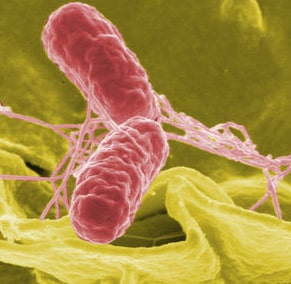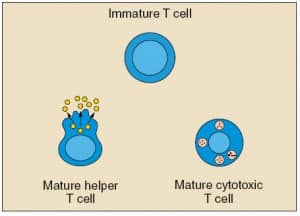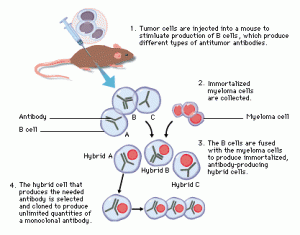Pathogen – a disease causing organisms
– May be:
– viral (HIV, chicken pox)
– bacterial (TB, strep)
– fungal (athletes foot)
– Protozoan (malaria = plasmodium)
– Flatworm
– Roundworm
How to get infected?
– airborne; waterborne; food; insect transmission; STI; skin
Barriers to infection – skin, mucous membranes
Specific defenses – production of antibodies to a specific antigen
Antigen – a molecule (protein) recognized as foreign by the immune system
Antibody – a globular, y-shaped protein that recognizes an antigen.
– produced by B-cells (a type of leukocyte)
Antibiotics – used to treat bacterial infections.
– Inhibit the function of bacterial (prokaryotic) proteins, preventing protein synthesis. Will not affect a virus, because a virus uses host cells to reproduce.
– Bacteria have short reproductive time, so can easy evolve to a resistance to an antibiotic. -> Super bugs
Production of Antibodies
- Pathogen invades body
- Antigen detected by macrophage
- Macrophage engulfs pathogen, and displays the antigen on the outside of its membrane
- T-Cells detect the antigen -> activate B-cells.
- B-cells produce antibody. B cells clone themselves
- Antibody binds to antigen “neutralizing it”
- Memory T-cells and B-cells are left behind. These reduce the response time to a second exposure.
Types of T-Cells
Helper T-cell – activate B-cells to produce antibodies
Killer (cytotoxic) T-cell – destroys infected body cells.
E.g. – Cancer cells.
Memory T-cell – remains in body to recognize antigen again
Suppressor T-cell – shuts down immune response
Vaccination
– Stimulates antibody production and formation of memory cells without causing the disease.
– Uses a weakened or dead pathogen.
– If person becomes exposed, immune response will be quick and person will probably not be infected again.
Immunization – deliberate exposure to the pathogen to produce memory cells against it.
Different classes of antibodies -> proteins known as immunoglobulins
– antibodies are y-shaped – 2 heavy chains (long)
– 2 light chains (short)
Class of antibody depends on the form of the heavy chain.
IgA – alpha *
IgG – gamma * * most common
IgE – epsilon
IgD – delta
IgM – mu
Monoclonal Antibodies
– Antibodies obtained from single B-cell clones.
– Produced in a lab using hybridoma cells
Uses – to prevent organ rejection
– to kill/inhibit cancer cells
– detect pregnancy (HCG)
– blood typing (blood will clot if antigen and antibody mix)
– produce vaccines
Immunity
1. Active – due to production of antibodies after exposure.
– once you have the disease you are unlikely to be infected a second time (measles, chicken pox)
2. Passive – immunity due to acquisition of antibodies
– E.g. – placenta or serum injection
– takes no time to develop
3. Natural – immunity due to infection
4. Artificial – immunity due to vaccination
The process of blood clotting is also another type of defense. Blood is too precious a liquid to allow it to escape in large amounts. As a result blood clots where there is a cut. But it is just as important that blood not clot at other times.
Clotting Process
- Blood reacts with air and platelets
- Damaged cells trigger release of enzyme thrombokinase
- Proteins in blood bind with factor X (10) and Ca2+
- Causes prothrombin (inactive) -> thrombin (active)
- Thrombin causes fibrinogen (soluble) -> fibrin (insoluble)
- Fibrin traps blood cells forming a CLOT.
Benefits and Dangers of Vaccination
Benefits
- “herd immunity” almost everyone in the community is immune against a disease.
- Eradication of a disease – e.g. smallpox
Dangers
- Live vaccines could be passed out through feces and infect others
- Some people do not respond to a vaccine and are not immune – malnutrition can prevent antibodies from being formed
- A virus like the common cold mutates regularly making previously formed antibodies useless.
- MMR Measles/Mumps/Rubella – a useful vaccine that protects against two most lethal childhood diseases Mumps and Measles.
